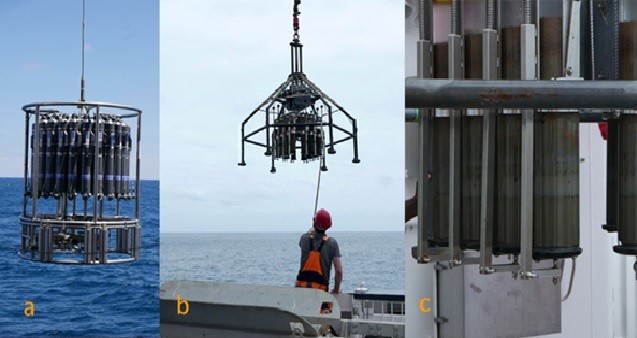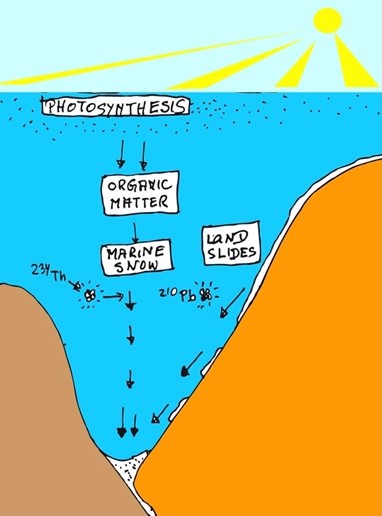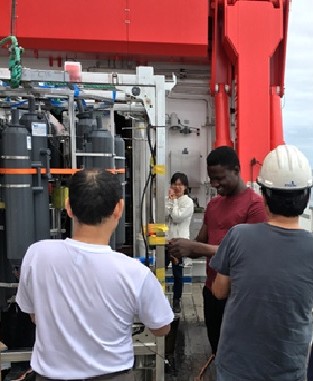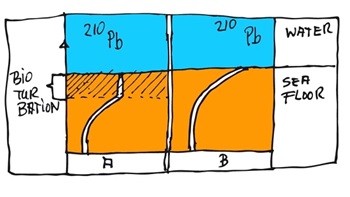- Press Office
- Blogs and More
- Organic carbon in the Atacama Trench - Blogpost 8 from RV SONNE, March 27, 2018
Organic carbon in the Atacama Trench - Blogpost 8 from RV SONNE, March 27, 2018
On Board RV SONNE, Chile
March 27, 2018
The research vessel Sonne is on her way to our last sampling sites. This morning the sky was overcast with temperatures around 20 degrees centigrade. We are about 60 nautical miles northwest of the city of Antofagasta and our hadal CTD rosette is back on deck after collecting bottom water at 7700 meters depth. The scientists are lining up to take subsamples from the bottles of seawater.
Sampling the Atacama Trench
The oceans are full of life. At the water surface, each liter of seawater contains around one billion microbes. In deep-sea trenches it is a hundred fold less – which still makes ten millions. Scientists calculated that all marine dissolved organic matter contains a similar amount of carbon as all living biomass on earth. For deep-sea trenches, it is still an unsolved mystery from where this organic carbon originates. Some of the scientists on board Sonne have discovered that the sediments of the deep-sea Atacama trench are very active. This activity is reflected in the steep oxygen profile found in the upper parts of the sediments. Microbes degrading organic matters consume oxygen, which has been penetrating into the sediments from the water column above.

Start of the food web
In the upper part of the water column light is the energy source for carbon fixation in photosynthesis. Unlike plants using carbon dioxide present in the air, the marine autotrophic counterparts like algae use bicarbonate as a carbon source. This is the starting point of the food web, as this carbon is used for biomass production. Under the right conditions, algae in the water start to grow and build so-called algal blooms. When these algal blooms fade out, the cells die and the dead cells sink to the ground of the sea floor. During the long way down, most of the matter is degraded by microbes. These microbes use the substances leaking out of the dead cells as a source of carbon and nutrients. They are called heterotrophs, and are the research field of Logan Peoples from Scripps Institution of Oceanography in San Diego.
Logan Peoples studies the in-vivo de-novo synthesis of proteins under the high pressure of 800 bar in 8000 meters depth in order to evaluate the turnover rates. He wants to find out how fast the cells can produce new proteins and how high pressure affects this rate. His experiment looks like this: A steel cylinder collects bottom water at a certain depth. It is equipped with valves and an injection device for tracer molecules. The bottom water contains microorganisms adapted to the 800 bar at 8000 meters depth. When the valves are open, the bottom water enters the cylinder. Subsequently, the microbes captured inside are fed with a specially labeled amino acid. When they start to grow, the fluorescence label is incorporated into the microbial protein. After a certain time period the microbes are collected on a filter. Counting the cells and the labels under a fluorescence microscope allows to calculate the synthesis rate. Theory would predict the synthesis rates to be significantly increased in the depths of the hadal environment. Logan Peoples’ goal is it to measure microbial activity under a variety of pressures to determine the pressure effect on communities that may be adapted to hadal constraints.
How to follow the particles on their way down - Naturally occurring radioactive substances as markers
As mentioned earlier, the remnants of dead cells clump together and form aggregates like snow flakes. This so-called marine snow finally reaches the sea floor, being the food source for other microbes in the sediment. How fast this vertical particle transport is can be calculated by measuring the ratios of certain naturally occurring isotopes in the water column.
These isotopes are present in extremely low concentrations. They are not from atomic reactors, accidents or leaks but part of nature on earth. It is known that there is a constant low concentration of 238Uranium in the seawater. When it decays, 234Thorium is produced, which strongly binds to particles like the marine snow. Its half-life time is only 24.1 days. When these particles settle on the seafloor, they constantly remove 234Thorium from the water column and add 234Thorium to the sediment. Therefore the ratios of thorium to uranium in the sediments and the water column are a good indicator for particle flow in the water column. This particle flow can be influenced by underwater geography, as cliffs and trenches can act as hydrodynamic obstacles and cause local currents.
Robert Turnewitsch from the Scottish Association for Marine Science (SAMS) has studied these processes for over ten years and was member of several other scientific cruises to deep-sea trenches like the Tonga trench. He says: ”From other trenches we know how unusually active they are. Here on this expedition to the Atacama trench we get excellent cores from the sea floor. I slice them into segments and extract the radioactive material. This I do also with water column samples. But I have to be very patient, as the low level radiation in my samples has to be measured over a couple of month to discriminate the different isotopes decaying with different half life times. We will get the final results in a couple of months.”

His colleague Kazumasa Oguri from JAMSTEC is using another naturally occurring radioactive isotope. 210Pb, or lead, is also present in low concentrations, but sufficient enough to study the history of the sea floor. This lead is deposited there and decays with a half-life of 22.3 years. Looking at the depth profile of different sites of the Atacama trench, the different sedimentation histories becomes visible.
Kazumasa Oguri says:” With our method we see what had happened in the sediment. Sometimes animals living there change the lead profiles due to bioturbation. They build burrows and mix the sediment. As a consequence, the lead in these bioturbation zones is on a constant level. Only below these zones we observe a decline of the lead profile according to its radioactive decay. Also, we see what signature submarine landslides in the past leave in the profile. We see how the profiles were disturbed similar to bioturbation. Here in the Atacama trench we want to document what happens when landslides from the shoulders of the trench occur.” Additional to his profiling, Kazumasa Oguri brought several high-resolution cameras with him to get an impression of the sea bottom topography.
Chemosynthesis instead of Photosynthesis
Below the photic zone the cells cannot use light for fixing carbon. Instead of photosynthesis, certain archaea and other bacteria use the energy stored in chemical compounds (e.g. ammonia, a reduced nitrogen compound) to fix carbon. How much this chemosynthesis contributes to the total organic carbon input to the trench system is the scientific question of our colleague XinXin Li from the Southern University of Science and Technology in China. Moreover, respiration occurs and oxidizes an unknown fraction of the organic matter. It is of scientific interest to calculate this carbon balance.
What will happen to the results from this cruise
All data collected during the cruise will be published in scientific journals and data banks accessible to the public.
Greetings from the crew and the scientific party of So261,
Manfred Schlösser
Specific questions addressed during this cruise are:
- What are the sedimentary processes providing food for the hadal community in the Atacama Trench?
- How do abundance, diversity and community structure of microorganisms, meio- and macrofauna in the Atacama Trench differ from those in less productive trenches and nearby abyssal and shelf sites?
- What are the general biogeochemical characteristics of the surface and deep sediment and water column in the eutrophic Atacama Trench?
- Which mineralization pathways are responsible for organic matter breakdown in the eutrophic Atacama Trench?
- How efficient are microbial communities operating at extreme hydrostatic pressures in mineralizing organic material as compared to their shallower counterparts? And to what extent do specialized, yet unknown extremophile microbial communities mediate these processes?
Further information
More details about the project from the University of Southern Denmark.
More pictures related to the project.
Ronnie N Glud at Danmarks Radio (in Danish)
RV SONNE is a modern German research vessel sailing mainly in the Pacific Ocean.
More information about the ship here.



